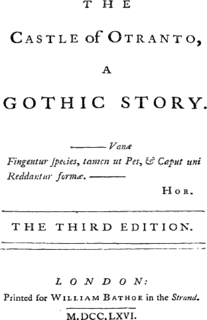Analysis of major themes
The inability of many Gothic characters to overcome perversity by rational thought is quintessential American Gothic. [1] It is not uncommon for a protagonist to be sucked into the realm of madness because of his or her inclination towards the irrational. A tendency such as this flies in the face of higher reason and seems to mock 18th-century Enlightenment thinking as outlined by "Common Sense (pamphlet)" and The Age of Reason . Also, one cannot ignore the contemporary Gothic themes of mechanism and automation that rationalism and logic lead to.

The Age of Reason; Being an Investigation of True and Fabulous Theology is a work by English and American political activist Thomas Paine, arguing for the philosophical position of deism. It follows in the tradition of 18th-century British deism, and challenges institutionalized religion and the legitimacy of the Bible. It was published in three parts in 1794, 1795, and 1807.
Puritan imagery, particularly that of Hell, acted as potent brain candy for 19th-century authors like Edgar Allan Poe and Nathaniel Hawthorne. [2] The dark and nightmarish visions the Puritan culture of condemnation, reinforced by shame and guilt, created a lasting impact on the collective consciousness. Notions of predestination and original sin added to the doom and gloom of traditional Puritan values. This perspective and its underlying hold on American society ripened the blossoming of stories like "The Pit and the Pendulum", "Young Goodman Brown", and The Scarlet Letter .

In religion and folklore, Hell is an afterlife location in which evil souls are subjected to punitive suffering, often torture as eternal punishment after death. Religions with a linear divine history often depict hells as eternal destinations, the biggest examples of which are Christianity and Islam, whereas religions with reincarnation usually depict a hell as an intermediary period between incarnations, as is the case in the dharmic religions. Religions typically locate hell in another dimension or under Earth's surface. Other afterlife destinations include Heaven, Paradise, Purgatory, Limbo, and the underworld.

Edgar Allan Poe was an American writer, editor, and literary critic. Poe is best known for his poetry and short stories, particularly his tales of mystery and the macabre. He is widely regarded as a central figure of Romanticism in the United States and of American literature as a whole, and he was one of the country's earliest practitioners of the short story. He is generally considered the inventor of the detective fiction genre and is further credited with contributing to the emerging genre of science fiction. He was the first well-known American writer to earn a living through writing alone, resulting in a financially difficult life and career.
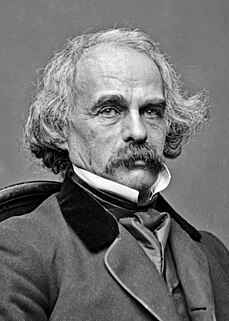
Nathaniel Hawthorne was an American novelist, dark romantic, and short story writer.
The dungeons and endless corridors that are a hallmark of European Gothic are far removed from American Gothic, in which castles are replaced with caves. Lloyd-Smith reinterprets Moby-Dick to make this point convincingly. [3] Early settlers were prone to fear linked to the unexplored territory which surrounded, and in some cases, engulfed them. Fear of the unknown stemming from environmental factors like darkness and vastness is notable in Charles Brockden Brown's Edgar Huntly .

Charles Brockden Brown was an American novelist, historian, and editor of the Early National period. He is generally regarded by scholars as the most important American novelist before James Fenimore Cooper. He is the most frequently studied and republished practitioner of the "early American novel," or the U.S. novel between 1789 and roughly 1820. Although Brown was not the first American novelist, as some early criticism claimed, the breadth and complexity of his achievement as a writer in multiple genres makes him a crucial figure in U.S. literature and culture of the 1790s, and the first decade of the 19th century. Brown was a significant public intellectual in the wider Atlantic print culture and public sphere of the era of the French Revolution.
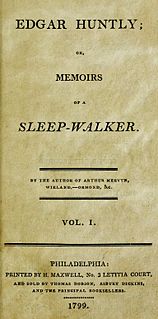
Edgar Huntly, Or, Memoirs of a Sleepwalker is a 1799 novel by the American author Charles Brockden Brown.
The emergence of the "ab-human" in American gothic fiction was closely coupled with the emergence of Charles Darwin's theories of evolution. [4] Ideas of evolution or devolution of a species, new biological knowledge, and technological advancement created a fertile environment for many to question their essential humanity. Parallels between humans and other living things on the planet were made obvious by the aforementioned. This is manifest in stories like H.P. Lovecraft’s "The Outsider" and Nicholson Baker's "Subsoil". Ghosts and monsters are closely related to this theme; they function as the spiritual equivalent of the abhuman and may be evocative of unseen realities, as in The Bostonians .

"The Outsider" is a short story by American horror writer H. P. Lovecraft. Written between March and August 1921, it was first published in Weird Tales, April 1926. In this work, a mysterious individual who has been living alone in a castle for as long as he can remember decides to break free in search of human contact and light. "The Outsider" is one of Lovecraft's most commonly reprinted works and is also one of the most popular stories ever to be published in Weird Tales.

Nicholson Baker is an American novelist and essayist. His fiction generally de-emphasizes narrative in favor of careful description and characterization. He often focuses on minute inspection of his characters' and narrators' stream of consciousness. Baker has written about poetry, literature, library systems, engineering, history, politics, time manipulation, youth, and sex. He has written about libraries getting rid of books and newspapers and created the American Newspaper Repository. He received a National Book Critics Circle Award in 2001 for his nonfiction book Double Fold: Libraries and the Assault on Paper and the International Hermann Hesse Prize (Germany) in 2014. Baker has also written about and edited Wikipedia. A pacifist, he has also written about the buildup to World War II.

The Bostonians is a novel by Henry James, first published as a serial in The Century Magazine in 1885–1886 and then as a book in 1886. This bittersweet tragicomedy centres on an odd triangle of characters: Basil Ransom, a political conservative from Mississippi; Olive Chancellor, Ransom's cousin and a Boston feminist; and Verena Tarrant, a pretty, young protégée of Olive's in the feminist movement. The storyline concerns the struggle between Ransom and Olive for Verena's allegiance and affection, though the novel also includes a wide panorama of political activists, newspaper people, and quirky eccentrics.
Julia Kristeva's concepts of jouissance and abjection are employed by American Gothic authors such as Charlotte Perkins Gilman. [5] Kristeva theorizes that the expulsion of all things defiling, much like a corpse, is a common coping mechanism for humanity. [5] Gilman's "The Yellow Wallpaper" exploits this concept. Furthermore, "The Yellow Wallpaper" can be read as a social commentary on the oppressive conditions women suffered in their home lives at the turn of the 20th century.

Julia Kristeva is a Bulgarian-French philosopher, literary critic, semiotician, psychoanalyst, feminist, and, most recently, novelist, who has lived in France since the mid-1960s. She is now a professor emeritus at the University Paris Diderot. The author of more than 30 books, including Powers of Horror, Tales of Love, Black Sun: Depression and Melancholia, Proust and the Sense of Time, and the trilogy Female Genius, she has been awarded Commander of the Legion of Honor, Commander of the Order of Merit, the Holberg International Memorial Prize, the Hannah Arendt Prize, and the Vision 97 Foundation Prize, awarded by the Havel Foundation.
In French, jouissance means enjoyment, in terms both of rights and property, and of sexual orgasm. The latter has a meaning partially lacking in the English word "enjoyment".
The term abjection literally means "the state of being cast off". The term has been explored in post-structuralism as that which inherently disturbs conventional identity and cultural concepts. Among the most popular interpretations of abjection is Julia Kristeva's, pursued particularly in her 1980 work Powers of Horror: An Essay on Abjection. Kristeva describes subjective horror (abjection) as the feeling when an individual experiences, or is confronted by, what Kristeva calls one's "corporeal reality", or a breakdown in the distinction between what is Self and what is Other.

"Young Goodman Brown" is a short story published in 1835 by American writer Nathaniel Hawthorne. The story takes place in 17th century Puritan New England, a common setting for Hawthorne's works, and addresses the Calvinist/Puritan belief that all of humanity exists in a state of depravity, but that God has destined some to unconditional election through unmerited grace. Hawthorne frequently focuses on the tensions within Puritan culture, yet steeps his stories in the Puritan sense of sin. In a symbolic fashion, the story follows Young Goodman Brown's journey into self-scrutiny, which results in his loss of virtue and belief.
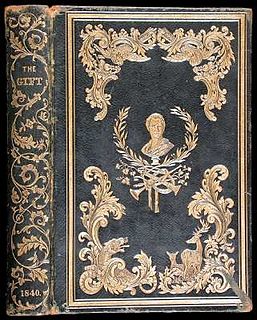
"William Wilson" is a short story by Edgar Allan Poe, first published in 1839, with a setting inspired by Poe's formative years on the outskirts of London. The tale follows the theme of the doppelgänger and is written in a style based on rationality. It also appeared in the 1840 collection Tales of the Grotesque and Arabesque, and has been adapted several times.

"The Minister's Black Veil" is a short story written by Nathaniel Hawthorne. It was first published in the 1832 edition of The Token and Atlantic Souvenir. It was also included in the 1836 edition of The Token and Atlantic Souvenir, edited by Samuel Goodrich. It later appeared in Twice-Told Tales, a collection of short stories by Hawthorne published in 1837.

The history of literature in the Modern period in Europe begins with the Age of Enlightenment and the conclusion of the Baroque period in the 18th century, succeeding the Renaissance and Early Modern periods.
Edith Birkhead (1889-1951) was a lecturer in English Literature at the University of Bristol and a Noble Fellow at the University of Liverpool. She wrote a pioneering work on Gothic literature: The Tale of Terror (1921). This work described the fascination with supernatural fiction in English literature from the publication of Horace Walpole's The Castle of Otranto in 1764 to Charles Maturin's Melmoth the Wanderer in 1820 on to modern times. She included works from Europe as well as America, including Nathaniel Hawthorne and Edgar Allan Poe.
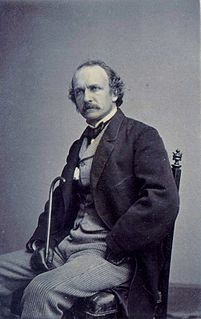
Felix Octavius Carr "F. O. C." Darley was an American illustrator, known for his illustrations in works by well-known 19th-century authors, including James Fenimore Cooper, Charles Dickens, Mary Mapes Dodge, Nathaniel Hawthorne, Washington Irving, George Lippard, Henry Wadsworth Longfellow, Donald Grant Mitchell, Clement Clarke Moore, Francis Parkman, Harriet Beecher Stowe and Nathaniel Parker Willis.
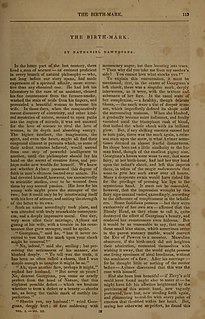
"The Birth-Mark" is a short story by American author Nathaniel Hawthorne. The tale examines obsession with human perfection. It was first published in the March 1843 edition of The Pioneer and later appeared in Mosses from an Old Manse, a collection of Hawthorne's short stories published in 1846.

Dark Romanticism is a literary subgenre of Romanticism, reflecting popular fascination with the irrational, the demonic and the grotesque. Often conflated with Gothicism, it has shadowed the euphoric Romantic movement ever since its 18th-century beginnings. Edgar Allan Poe is often celebrated as one of the supreme exponents of the tradition.

Wieland: or, The Transformation: An American Tale, usually simply called Wieland, is the first major work by Charles Brockden Brown. First published in 1798, it distinguishes the true beginning of his career as a writer. Wieland is sometimes considered the first American Gothic novel. It has often been linked to Caleb Williams by William Godwin. Godwin's influence is clear, but Brown's writing is unique in its style. Wieland is often categorized under several subgenres other than gothic fiction, including horror, psychological fiction and epistolary fiction, which are listed at Project Gutenberg.

Park Benjamin Sr. was well known in his time as an American poet, journalist, editor and founder of several newspapers.

Tales of the Grotesque and Arabesque is a collection of previously published short stories by Edgar Allan Poe, first published in 1840.

Radio Tales is an American series of radio drama which premiered on National Public Radio on October 29, 1996. This series adapted classic works of American and world literature such as The War of the Worlds, Twenty Thousand Leagues Under the Sea, Beowulf, Gulliver's Travels, and the One Thousand and One Nights. The series was co-produced by Winnie Waldron and Winifred Phillips. Waldron created the series and served as on-air host. Phillips composed music for the series.
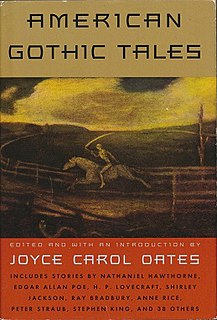
American Gothic Tales is an anthology of "gothic" American short fiction. Edited and with an Introduction by Joyce Carol Oates, it was published by Plume in 1996. It featured contributions by Washington Irving, Nathaniel Hawthorne, Edgar Allan Poe, Stephen King, Anne Rice and others, and included over 40 stories.

The works of American author Edgar Allan Poe include many poems, short stories, and one novel. His fiction spans multiple genres, including horror fiction, adventure, science fiction, and detective fiction, a genre he is credited with inventing. These works are generally considered part of the Dark romanticism movement, a literary reaction to Transcendentalism. Poe's writing reflects his literary theories: he disagreed with didacticism and allegory. Meaning in literature, he said in his criticism, should be an undercurrent just beneath the surface; works whose meanings are too obvious cease to be art. Poe pursued originality in his works, and disliked proverbs. He often included elements of popular pseudosciences such as phrenology and physiognomy. His most recurring themes deal with questions of death, including its physical signs, the effects of decomposition, concerns of premature burial, the reanimation of the dead, and mourning. Though known as a masterly practitioner of Gothic fiction, Poe did not invent the genre; he was following a long-standing popular tradition.

Urban Gothic is a subgenre of Gothic fiction, film horror and television dealing with industrial and post-industrial urban society. It was pioneered in the mid-19th century in Britain, Ireland and the United States and developed in British novels such as Robert Louis Stevenson's Strange Case of Dr Jekyll and Mr Hyde (1886), and Irish novels such as Oscar Wilde's The Picture of Dorian Gray (1890), and Bram Stoker's Dracula (1897). In the twentieth century, urban Gothic influenced the creation of the subgenres of Southern Gothic and suburban Gothic. From the 1980s, interest in the urban Gothic revived with books like Anne Rice's Vampire Chronicles and a number of graphic novels that drew on dark city landscapes, leading to adaptations in film including Batman (1989), The Crow (1994) and From Hell (2001), as well as influencing films like Seven (1995).
The Mind's Eye was a theater company which produced dramatized radio adaptations of various written works, most notably the 1979 National Public Radio broadcast of J.R.R. Tolkien's The Lord of the Rings and in 1980, The Hobbit. Its works have been distributed by Soundelux and Highbridge Audio. Prominent players include Bernard Mayes, Erik Bauersfeld, John Vickery, Lou Bliss, Gail Chugg, Tom Luce, Ray Reinhardt, James Arrington, Pat Franklyn, Wanda McCaddon, Rick Cimino, Joe Gostanian, John Joss, Karen Hurley, Kevin Gardiner, Darryl Ferreira, and Carl Hague.
American Fantastic Tales is a set of two reprint horror anthologies, released as American Fantastic Tales: Terror and the Uncanny from Poe to the Pulps and American Fantastic Tales: Terror and the Uncanny from the 1940s to Now. Both anthologies were edited by Peter Straub. They were published by Library of America in 2009. The anthologies contain horror stories by American authors from the 18th century to modern times, split at 1940. The anthology pair itself won the 2010 World Fantasy Award for Best Anthology. The pair were also released as a boxed set in 2009.
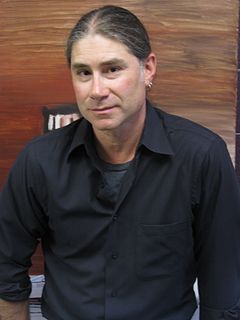
Jeffrey Andrew Weinstock is an American literature, film, and media scholar who has been teaching in the Department of English Language and Literature at Central Michigan University since 2001. He has authored or edited twenty-one books and a range of articles focusing on the American Gothic tradition, monsters, cult film and television, popular culture, weird fiction, pedagogy, and goth music. He is also an editor for the academic journal The Journal of the Fantastic in the Arts.
